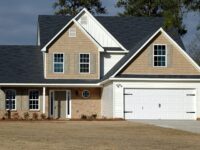The following contribution is from another author.
Even at the best of times, the roof replacement process can be a huge undertaking, requiring multiple steps over several days of work. It is even more involved, however, if the roof being replaced has experienced roof rot to any degree. Roof rot is one of the most insidious issues that homeowners face, as it can spread undetected for years before ultimately causing catastrophic damage. What’s more, if it’s not properly repaired, or if the underlying causes are not addressed, roof rot can reoccur and compromise your new roof.
Below, we’ll explain how professional roofers will repair or replace a roof that has developed rot. We’ll also offer preventative tips to avoid a recurrence of this all-too-common problem.
What Causes Roof Rot?
What we refer to as “roof rot” is actually caused by the growth of xylophagous fungus. This fungus has several distinct types, which are categorized by the types of decay that they cause. The most common variety that attacks roofs is known as white rot fungus. These fungi actually serve a very important purpose in nature as decomposers, meaning they help to break down fallen trees and return their nutrients to the earth. While this process may be natural and necessary for the survival of forests, it’s one you should try to avoid occurring in your home.
Signs to Watch For
In order to thrive, the fungus that causes roof rot needs two things: wood and water. Your roof provides the wood, but the fungus can’t take hold if there isn’t a good source of moisture. This means that a roof with leaky shingles or a home with a poorly ventilated attic that is full of moist air is likely to be far more vulnerable to roof rot. The first sign you should watch for that may serve to warn you that your home is at risk is bare patches where the shingles have been lost. This is more likely to occur on older roofs or on those that have been subjected to heavy winds for long periods of time.
Moisture in the attic area is another telltale sign that a roof may be at risk of rot, as are any discolored areas directly below the roof. If you feel moisture when you place your hand anywhere in the attic, this could be the result of a leak and could soon lead to roof rot. You may also notice dark, or even black, streaks lining the rafters. These streaks are fungi growing across areas that regularly drip with water. They could indicate roof rot is beginning to take hold.
If you notice that the roof itself is beginning to bulge or sag, this can indicate that the rot has become extensive, and the roof may need to be replaced. Contact a professional roofer immediately if you see any signs of this.
If You Need a Roof Replacement
Not every case of roof rot necessitates a full roof replacement. Some cases can be isolated and repaired without compromising the entire roof. By the same token, not every roof replacement is a result of rot. Roofs are replaced due to normal wear and tear every few decades. However, when a roof that has extensive wood rot needs to be replaced, the process can prove to be a difficult one.
The roof replacement process begins the same way it always does: you contact a certified roofer that specializes in roof replacement, such as Interstate Roofing. These roofers will start by tearing away the old roof. They’ll pry away all the shingles and strip the underlayment from the roof. This will reveal the decking, which is generally made from plywood. It’s this part that is vulnerable to roof rot. Your roofer will then visually inspect the damage. In some cases, they may be able to remove only the rotten sheets of decking and replace it with new, fresh plywood. If the damage is extensive, they may have to replace most or all of your roof decking.
Once the decking has been repaired or replaced, your roofer can add new underlayment and new shingles. They may also opt to replace the flashing, gutters, and/or insulation in the attic.
Preventing the Problem From Recurring
Keeping the plywood decking dry is the most important step to ensure that water damage does not cut your roof’s life span short. In short, hiring a professional roofing contractor with years of experience is the best thing you can do. Your roofing contractor may also be able to replace the insulation in your attic, which will help to control the humidity
You can also consult with your roofer about wind-resistant shingles. Some of these are rated to withstand winds of up to 130 miles per hour. If heavy winds cannot blow your shingles away, your roof will be less vulnerable to bare patches that can let water in.
Avoiding damage to your new roof is also a matter of proper maintenance and care. It’s important to make sure the insulation is up to par everywhere in the house, not just in the attic. If you feel cold walls or ceilings, or if your home has become drafty, you may want to consider having new insulation installed. Besides protecting your roof, this can help bring down your energy bills and make your home more comfortable.
Regular maintenance and repair by a certified roofer like the professionals at Interstate Roofing is another way to avoid roof rot. Occasional inspections can help to detect maintenance issues when they are still minor. In doing so, you can avoid small issues turning into major problems. Consider also investing in a replacement roof that comes with a warranty. This way, if you have any problems down the road, you can have them corrected free of charge.
Finally, hiring an HVAC contractor to inspect the attic after the roofing work is complete is another great idea. They can make sure all ducting in the attic is adequately moving from the moisture source to the exterior. Even a perfectly installed roof will rot if ducts are allowed to pump warm moist air into the attic.
















